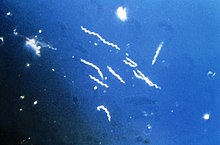Lyme disease
| Classification according to ICD-10 | |
|---|---|
| A68 | Relapsing fever |
| A68.0 | Lice-borne relapsing fever caused by Borrelia recurrentis |
| A68.1 | Relapsing fever transmitted by ticks, relapsing fever from any type of Borrelia except Borrelia recurrentis |
| A69 | Other spirochete infections |
| A69.2 | Lyme disease, erythema chronicum migrans due to Borrelia burgdorferi |
| ICD-10 online (WHO version 2019) | |
Borreliosis is a general term for various infectious diseases caused by bacteria of the genus Borrelia (commonly known as Borrelia ) from the group of spirochetes . The diseases occur in humans and in all other mammals and can trigger a variety of clinical symptoms by affecting all body tissues. It is mainly transmitted by ticks , but also by horseflies .
The genus Borrelia and the borreliosis disease derived from it are named after the French bacteriologist Amédée Borrel .
Lyme disease
Lyme disease or Lyme disease (after the town of Lyme, Connecticut ) is caused by the bacterium Borrelia burgdorferi . All organs and tissues can be affected. The disease occurs in humans and all other mammals and birds . It is mainly transmitted by the wood tick , a type of tick , and its larva, known as the nymph , and very rarely also by mosquitoes or horseflies . The nymphs are barely visible to the naked eye. Since they fall off the skin after their usually unnoticed meal of blood, the person bitten knows nothing of a possible Lyme disease infection and only becomes aware when the symptoms appear. In the main article Lyme borreliosis , the three disease stages, diagnostic options and treatment are described in more detail.
Relapsing fever
Relapsing fever (English relapsing fever, spirillium fever ) is understood to mean two bacterial infectious diseases caused by relapsing fever Borrelia, which are characterized by repeated attacks of fever, so-called recurrent fever. Relapsing fevers are transmitted by lice and ticks and thus belong to the group of bacterial zoonoses or arthropozoonoses (diseases transmitted by arthropods). Relapsing fevers detected in Central Europe are all rare, imported medical travel diseases. Two types of relapsing fever are known to differ according to the pathogen and transmission:
- the rare, but then mostly epidemic, louse relapsing fever (LBRF ), the main pathogen is Borrelia recurrentis ;
- the ticks relapsing fever (English Tick-borne relapsing fever, TBRF ), usually by Borrelia duttoni caused.
More borreliosis
In animals there are other borreliosis that have not yet been described as an infectious disease in humans, such as infections with Borrelia theileri or Borrelia coriaceae (cattle and horse borreliosis), Borrelia latyschewii (reptiles) and Borrelia anserina (poultry).
literature
- Hartmut Krauss among others: Borrelioses. In: Hartmut Krauss, Albert Weber, Burkhard Enders (Eds.): Zoonoses. Infectious diseases that can be transmitted from animal to human. 3. Edition. Deutscher Ärzteverlag, Cologne 2004, ISBN 3-7691-0406-4 .
- Norbert Satz: Clinic of Lyme Borreliosis. 3. Edition. Verlag Hans Huber, 2010, ISBN 978-3-456-84763-4 .
Walter Berghoff Lyme borreliosis 1st edition, Berghoff Verlag, Rheinbach, 2016, ISBN 978-3-9817-7050-6 .
Web links
Individual evidence
- ^ Guideline on neuroborreliosis of the German Society for Neurology . In: AWMF online (as of 2012).
